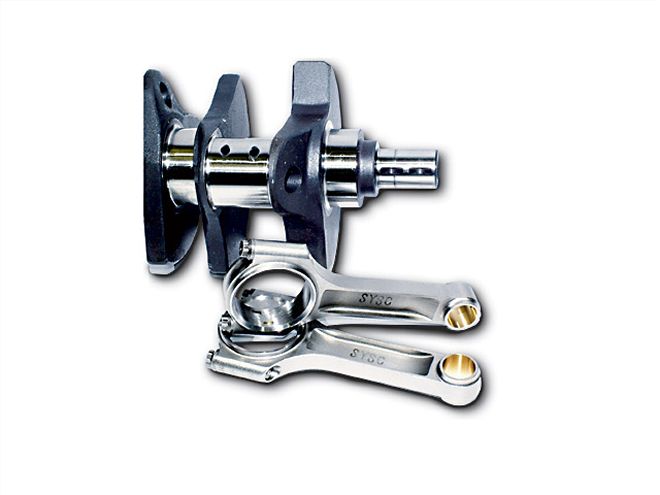
Make one crucial mistake, and big inches can spell big disaster. Here I've paid my dues the hard way, and for that matter, the expensive way when it comes to pulling all the inches possible from a block and crank assembly. Most of these lessons were learned while I lived in England, and the engines I built were mostly small four-cylinder units.
My most enduring disaster was a Ford Lotus twin-cam build. The engine, as it comes in a Ford Lotus Cortina, displaces 1,498 cc (91.4 inches). It had a deep-breathing Hemi twin-cam head, and if you knew what you were doing, could punch out about 200 hp. That, for 1965, was not too shabby. With as much flow as the head could deliver, it looked like it could handle much more displacement under it. Without going overly into detail, a block bored to what was normally considered safe was acquired along with a stroker crank and the appropriate rods and pistons.
For an underpaid aerospace engineer, this was a considerable investment. What the money and effort bought was a bottom end that displaced almost 1,800 cc. That represented a displacement increase of almost 20 percent. Putting this into perspective, that was like stretching a 327 small-block Chevy (at this time the 350 was still in the future) to an unheard of 390 inches. On the dyno, things looked good. As the fuel injection and timing were dialing in, the torque came up. At about 145 lb-ft, this twin-cam had already surpassed the 122 hp we had seen from a 1,498 unit by a good margin. At 7,000 rpm the engine was approaching the magic 200hp mark when it stopped in an instant. No warning, no apparent slowing down, just a seemingly instant stop. I stared in a state of disbelief. What, I asked myself, could stop an engine from 7,000 rpm to zero in no time flat?
About that time something caught my eye on the dyno window, so I refocused from the engine to the window. There, I could see a horizontal thin brown line across the window. I then noticed this brown line went entirely around the dyno cell and, as I watched, it slowly got wider. The reality of the situation then hit me--the engine had split a cylinder and hydraulically locked on the water that had become trapped above the cylinder-wall split. It then lifted the head and shot the water out horizontally at very high speed. I actually manage to remove about 90 percent of the head gasket without removing the head.
What I salvaged from the hydraulic mess amounted to three rods and pistons, the pan, the fuel injection, and the cam cover. The rest, including the head, (which was bent about an eighth of an inch) was junk. The crank, amazingly enough, did not break, but the big end journal of the offending cylinder was realigned by about 45 degrees. One thing is for sure about disasters: they teach you what not to do really fast. What I learned here was not to so readily accept that the overbored cylinders are still thick enough to hold out. It was some years before I once more attempted overboring one of these small Fords above the normally accepted plus-40 or -60 sizes. This time I took the block for what would be a maximum-effort engine to Cosworth for sonic testing to establish just how thick (or otherwise) those cylinder walls were. And, should you be wondering, the moral of this story is that the block is the case of the engine. Due to both cylinder pressure and reciprocating loads it has to contain all the forces. In a high-output engine, these are considerable. The fact of the matter, especially when inches are achieved with an overbore, is that power and block strength are going in opposite directions. The price for trying too hard to maximize an engine build on a minimal block is much higher than starting with a block of known capability.
For most hot rodders, big inches are almost a fatal fascination, but to make big numbers and retain reliability it is important to stick to a few important rules. Let's start with the most important.
Retain Block Integrity
If you are looking for additional cubes, then the first source should always be from an increase in bore size. Why? Because other than the possible loss of sufficient cylinder-wall integrity, there is no down side. Bigger bores increase displacement without a significant increase in bore friction and they allow the valves to be unshrouded a little more for a small improvement in breathing. Buy a good set of pistons, and the reciprocating weight is unlikely to change much. Also, when a stroker crank is used with a big bore it adds more inches than with a smaller bore.
An example here shows the difference. Assuming a 3.48-inch stroke as a starting point, installing a 3.85-inch stroke crank in a small-block Chevy with a 4.03-inch bore results in 37.8 extra cubes. Making the same crank change but with a 4.155 bore (400 block) delivers 40.1 extra cubes.
When you are looking for all the bore size possible, it is the sonic tester, not the boring bar, that is your best friend. If time is spent with a sonic tester measuring thickness of production factory blocks (especially small-block Fords) it won't take long for you to realize the limitations being dealt with. Unless you own a sonic tester and test every block that passes your way, you will quickly realize the benefits of going straight to a good aftermarket block. Of late I have been working up experience with Dart's blocks, especially its Ford blocks. Factory-produced Ford blocks are cast using what Ford calls a thin wall casting technique. Sounds good if you want a lightweight engine, but it spells death to big overbores. What partly saves Ford's thin walls on its small blocks is that the unsupported water-jacketed length is considerably shorter than its Chevy counterpart. This means it can get away with a slightly thinner wall thickness.
About one in ten 5.0 blocks have cylinder walls consistently in the 180 thousandths range. At the other end of the scale, a not-so-good casting can be down in places to under 90 thousandths. A thick block will stand a 60 overbore; a thin one isn't even safe at stock size!
Windsor 351 blocks, especially the older ones, are usually thicker. By spending time with a sonic tester I have found blocks with cylinder walls in the 200 to 250 range. But, time is money, and at the end of the day, if I want a serious big-inch Ford, I pick up the phone and order a Dart Ford block. These consistently have cylinder walls in the 375 thousandths-plus range and are cast using a much better grade of cast iron than the stock factory blocks. With a 4.125 stroke crank and a little re-pitching of the bores, these blocks will go to a comfortable 460-plus inches and still have the strength to contain over 1,500hp output. For more details, I suggest you hit its Web site at www.dartheads.com.
With Chevy blocks we are in somewhat of a better situation as far as block integrity goes. For the most part, factory Chevy blocks are good--at least for anything other than endurance racing (Cup car and the like) to power levels in the 700-800hp range. Find a thick 400 block or a regular Bow Tie block and bore sizes up to 4.185 are no problem. Once in a while a really thick one comes along that will go to as much as 4.250 on the bore. With a 4-inch stroke, that makes 454 inches, but that is almost certainly the limit for a stock-configuration small-block Chevy. To get even a 4-inch stroke into the block it is necessary to run a cam with a smaller base circle in order to provide clearance for the shoulders of the con rods. The solution here is the Rocket-style block. This was originally made exclusively for GM by Dart, but has been available for some years now direct from Dart. These beefy blocks have the pan rails wider apart for longer stroke cranks, and the camshaft centerline has been moved up some 390 thousandths to give rod clearance. Also, it is now practical to go to a 4.25-inch bore using the big bore (up from 4.185 to 4.250 bore) Fel-Pro 1036 head gasket. To date, the biggest I have worked on with these blocks is 468 inches (4.185 bore x 4.25 stroke) and I am currently working on a 482-inch one (4.25x 4.25). These engines are what I call regular big motors. The next category above that are the super-big motors that take a lot of time and effort to piece together. Sonny Leonard, who is most likely to collect the award for crown prince of super-big-inch motors, has built a 502-inch small-block using the Dart block, but be aware, he is not in business to tell you how it was done.
As far as big-blocks go, we find that given a sonic tester, many factory blocks will bore 100 over and quite a few at 125 over. Past that, you are back to aftermarket blocks from Dart, Bill Mitchell, and the like. If you have a good big-block Chevy-block that is capable of going to a 4.375-inch bore (125 thousandths over) then a relatively inexpensive way to bump that to 511 inches is to install a 4.25 stroke crank. Scat is a good source here, but a new name on the block for budget cranks at a good price is SYSC. If you find a really thick big-block Chevy, there can be enough cylinder wall material to bore as much as 250 thousandths over (540 inches), but these are not that common. Even if you do find a good stock block, there can be a lot of work required to transform it into a good candidate for a high-output big-inch unit.
Accept Realistic Geometric Block Limitation
To sum up the initial problems arising when stretching production factory blocks, we can say that bore size is limited by casting thickness, and crank stroke by crank case clearance problems (including hitting the cam). So for cylinder walls, how thin is too thin? For engines producing 3 hp-per-cube, I personally do not like to have less than 200 thousandths at the thinnest part. On real street engines, even with a moderate dose of nitrous, 180 thousandths will work.
What is marginal? This is not easily answered because many factors influence the situation. Not only is the thickness of the cylinder wall a factor, but also its unsupported length. If you are building a 302 small-block Ford you can get away with thinner cylinder-wall values because the water jacket is only about half the length of that used for a small-block Chevy. For a small-block Chevy, when cylinder wall thicknesses gets down to about 5/64-inch (140 thousandths), then things are getting a little on the thin side. The fact that the cores shift during the block casting can also mean that the cylinder walls are generally thicker in most places, but could have some areas that are dangerously thin. The way to counter the negative effect of these thinner sections is to partially fill the block. Filling the bottom half of the water jacket can substantially increase support for the cylinder walls while having zero effect on water temperature, although the oil will run hotter. Race Engineering in Lake Worth, Florida (561-533-5500), sells easily poured block filler.
The forgoing are not the only factors weighing against success with big inches. Remember, the idea is to make big output, not just be able to brag about cubes. When the stroke is increased, the con rod length really needs to be increased in proportion, or maybe more. A short rod-to-stroke ratio brings about more piston-to-bore friction, and that's not good for power. Unfortunately, many production blocks are just too short to be able to get a decent rod/stroke ratio. This makes a tall-deck aftermarket block just that much more desirable.
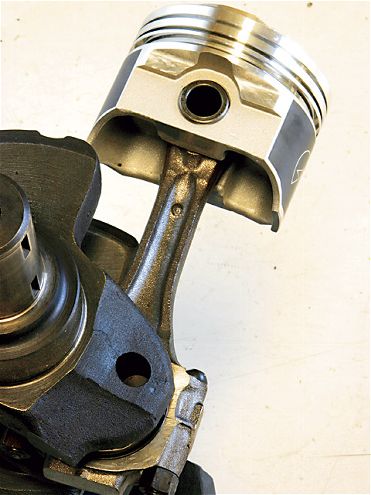
Understand Stroke Limitations and Piston Speed
There have probably been more stroker motors built in the last 10 years than there were in the previous 90. The proliferation of inexpensive, stronger-than-stock cranks has brought an entry-level stroker kit within almost every hot rodder's financial reach. But there are limitations as to how much stroke can be used. Any time stroke length is increased we either have to accept increased piston/rod accelerations (and therefore loads) or a reduction in redline rpm. For the most part we can calculate about where to set the engine's redline rpm from a given mean piston speed. The formula is simple: Mean Piston Speed (feet per minute) x 6 divided by the stroke in inches. Fig. 1 shows the formula and an example.
 These SYSC forged crank and rods are going into the UNC Charlotte Motor Sports drag car. It is the foundation of an 8,000-rpm 406. The rods, which carry very little surplus weight, are among the lightest of the budget-priced rods available.
These SYSC forged crank and rods are going into the UNC Charlotte Motor Sports drag car. It is the foundation of an 8,000-rpm 406. The rods, which carry very little surplus weight, are among the lightest of the budget-priced rods available.
The next problem that needs to be addressed is balance. The longer the stroke, the more difficult it becomes to achieve internal balance. Sure, we can go the external balance route, but this is a bandage fix because it exaggerates the bending moment on each end of the crank. This is not such a worry on the rear of the engine, but it can be on the front, where a lot of crank snout is hanging out there for accessory drives. Also, the longer the crank's stroke, the less its torsional rigidity. All of this adds up to a more flexible crank, thus putting greater demands on the crank damper. At the end of the day, tortional vibrations and bending moments can kill a crankshaft faster than the loads produced by power and rpm. Effective dampers are readily available for common stroker configurations; this won't be the case of the more specialized big-inch combinations. The route many top engine builders take here is to employ the custom damper building service offered by ATI. Going this route allows the damper to be zeroed-in on critical torsional and bending moments.Another factor to take care of is the crankcase. Firstly, oil is picked up by a long-stroke crank easier and sooner than a short-stroke one. This means that a good pan design is a must. Along with this, the effects of block distortion and ring seal have to be catered for. A good pan vacuum is a great help here. Not only does it ensure a better ring seal, but also, the lower crankcase pressure encourages the oil to drop out of suspension quicker, thus cutting windage losses.
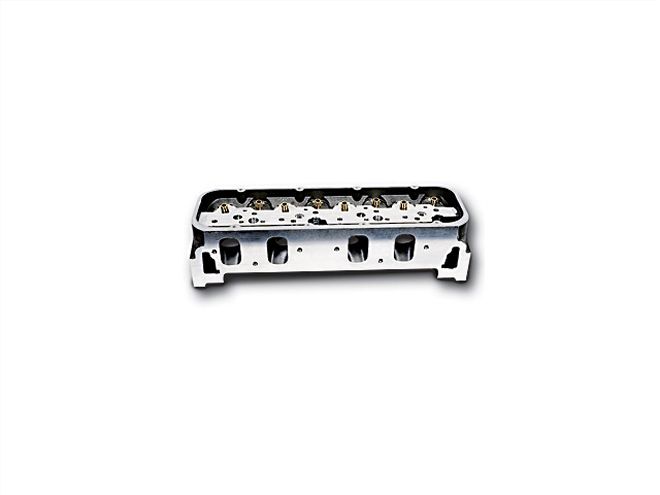 If you have a big-inch small-block Chevy to feed, Dart's Little Chief head should be high on your priority list. Its canted-valve design emulates a Pro Stock-style big-block head and, with an intake a hair under 2.25 inches, it flows some big numbers throughout the lift range.
If you have a big-inch small-block Chevy to feed, Dart's Little Chief head should be high on your priority list. Its canted-valve design emulates a Pro Stock-style big-block head and, with an intake a hair under 2.25 inches, it flows some big numbers throughout the lift range.
Maximize Rod and Piston Capability
Like every other part in a maximum-inch motor, the specification and design of the rods and pistons become more critical. Let's look at pistons first. Because we're trying to get as many cubic inches out of the block as possible, there is a need not only to accommodate the longer stroke, but also to try and get a good rod-to-stroke ratio. That means trying to accommodate as long a rod as is possible. This inevitably pushes the wrist pin high up into the ring pack. For most practical purposes, a wrist pin centerline-to-piston deck height (compression height) of 1-inch is about the practical limit. Sure, if you elect to use two-ring pistons the compression height can be cut further, but not by much. Also because of the long stroke that will inevitably be involved in a big-inch motor, the piston weight becomes more critical if reciprocating loads are to be kept to a minimum. This is a little easier said than done because a long stroke (and a rod often too short for the job) usually means the piston skirts and cylinder walls are side-loaded to a far higher degree. This situation calls for a structurally stiff piston. The pin often becomes a part of that structure. Those super-lightweight pins seen regularly in short-stroke, high-rpm engines usually just don't cut it in big, long-stroke mountain motors.As far as rods are concerned, we find (assuming a race-spec rod to start with) these pins do not grow in cross-section as quickly as whatever stroke increase is involved. The reason for this is that as stroke is increased, the rpm involved drops, so piston speed and acceleration peaks remain about the same. The result is a mountain motor rod that won't be as fat or weighty as you might expect it to be.
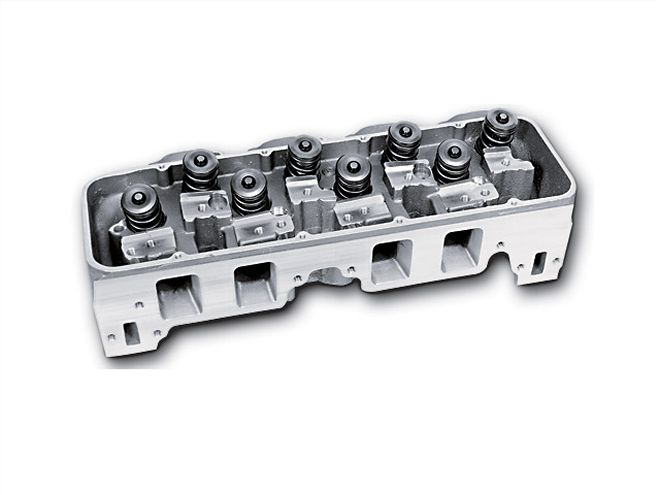 The proven performance of Dart's Big Chief head has (relatively speaking) been an affordable favorite for many big-inch engine builders. Available in 18-, 14, and 11-degree designs, the 11-degree tops the bill...
The proven performance of Dart's Big Chief head has (relatively speaking) been an affordable favorite for many big-inch engine builders. Available in 18-, 14, and 11-degree designs, the 11-degree tops the bill...
Optimize Heads and Cylinder Filling for Power
As the engine's cylinder proportions are increased, it becomes harder to extract a proportional increase in power. Just after World War II, it was considered that, in normally aspirated form, 125 hp-per-cylinder was about the limit with the materials, oils, fuels, and technology then available. These days, better materials, modern fuels and oils, flow benches, and valvetrain dynamics have allowed the 125hp figure to be exceeded by a big margin. Currently, a good mountain motor can put out over 200 hp-per-cylinder, but it hasn't, nor will it ever, come easily. The reason for this is largely a question of proportions and geometry. It is better, if you are attempting to build a given size engine, to have a lot of smaller cylinders rather than a few large ones. At first, this does not seem to make sense, so let's go through the logic to demystify things.
Even if all the proportions stay the same, it is harder to fill a large cylinder than it is a proportionately identical, but smaller cylinder. An example here will serve to illustrate the situation. Let's take a 180-inch single-cylinder engine as a starting point. Let us also assume that this engine has a bore/stroke ratio of 1.2 (bore is 1.2 times that of the stroke) and the intake valve is 50 percent of the diameter of the bore. If this 180-inch engine has just one cylinder, the intake valve would be 3.252 inches in diameter, the valve's area 8.306 inches, and it's circumference 10.22 inches. For a cylinder head equipped with this valve to breathe effectively, it would need to be lifted in the order of 970 thousandths, minimum.
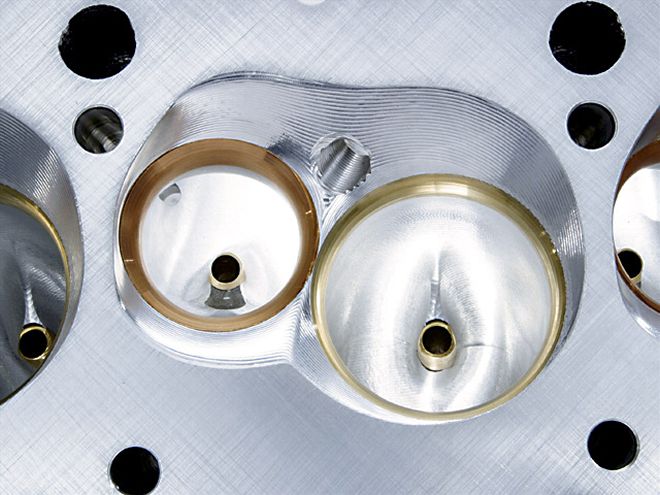 ...With a 2.5-inch intake valve, flow (as measured on a Superflow 600 and corrected to 28 inches) peaks out at just shy of 540 cfm, and the small chamber (as little as 55cc) means very high compression without big piston crowns.
...With a 2.5-inch intake valve, flow (as measured on a Superflow 600 and corrected to 28 inches) peaks out at just shy of 540 cfm, and the small chamber (as little as 55cc) means very high compression without big piston crowns.
Now let us consider an eight-cylinder engine of 180 inches. This engine, with the same proportions, would have an intake valve diameter of 1.626 inches. All eight intake valves would have a combined area of 16.612 inches and a total circumference of 40.88 inches. The lift needed to get near maximum flow would be only 487 thousandths. In a nutshell, this means the eight small cylinders of 180 inches have approximately twice the breathing power of one big cylinder of 180 inches, even though the proportions of valve diameter-to-bore remain unchanged. Also, if we assume 5,000 feet per minute maximum piston speed, the maximum rpm of the one-cylinder engine would be 5,500 where as it is 11,000 for the eight-cylinder engine. There are other factors involved, but from this you can see the reason why it is harder to extract power from big cylinders rather than a greater number of small ones. You can also get an idea of how ultimately these and other limitations call a halt to the amount of power that can be had per cylinder.
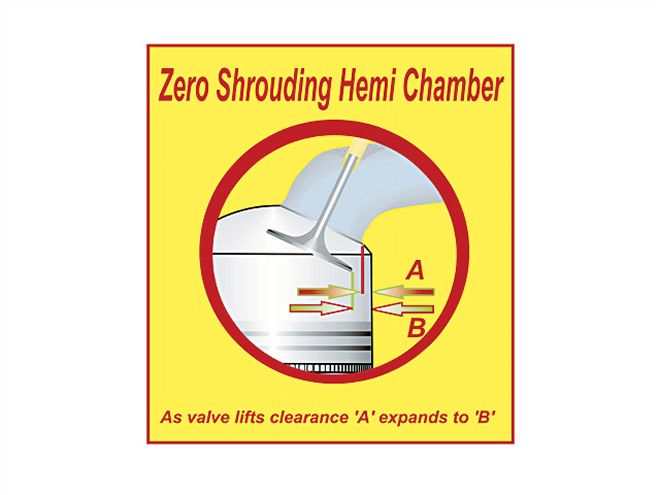 Not all valve and combustion chamber layouts have shrouding. The classic Hemi-style shown here has virtually no shrouding because as the valve opens, it moves away from all surrounding surfaces including the cylinder bore.
Not all valve and combustion chamber layouts have shrouding. The classic Hemi-style shown here has virtually no shrouding because as the valve opens, it moves away from all surrounding surfaces including the cylinder bore.
Understanding these limitations allows us to make moves that help optimize what can be done within the constraints of having only eight cylinders. Firstly, because filling the cylinders is going to be a problem with any type of conventional head design, we find that bumping the CR as high as possible becomes a priority. To get to high compression without compromising the combustion chamber shape means that the bore of the engine cannot get too big in relation to the stroke. Indeed, it is often found that engines with a stroke a little longer than the bore pay off when a very high compression is sought. But this leads to conflicts within itself. With a long-stroke motor having proportionally less bore, the size of the valves is further compromised.Although few in number, one point going for us here is that the higher the compression goes, the less the exhaust needs to flow to get the job done. Consequently, we can increase the intake valve size at the expense of some exhaust valve size. Another factor is the type of cylinder head used. If we are talking two-valve-per-cylinder heads, a Hemi-style head has a better breathing capability than a vertical-valve head. So the longer the stroke of the engine, the more the use of a Hemi head pays off.
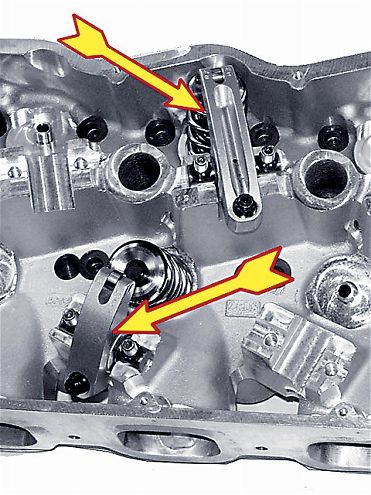 Here are the rockers on a Sonny Leonard GM Hemi head. Note the intake's (upper arrow) long arm on the valve side. This rocker produces a ratio around the 2:1 mark. The exhaust has a much lower ratio (1.7:1 to 1.8:1) as exhaust flow is not as critical on a very high-compression engine because the exhaust event can be started sooner without compromising hp.
Here are the rockers on a Sonny Leonard GM Hemi head. Note the intake's (upper arrow) long arm on the valve side. This rocker produces a ratio around the 2:1 mark. The exhaust has a much lower ratio (1.7:1 to 1.8:1) as exhaust flow is not as critical on a very high-compression engine because the exhaust event can be started sooner without compromising hp.
Pay Close Attention to the Valvetrain--or Fail
We have already found that the bigger the cylinder is, the harder it is to fill. As if that is not problem enough, we find there are also some critical issues with the valvetrain that need to be addressed for success with any bigger-than-normal engine. It has already been ascertained that, for almost any bored/stroked motor, a two-valve head is inadequate. This being the case, it is very important that the intake valve is opened as fast as possible to give an air-hungry cylinder the best access possible to the port's airflow. The need to open valves very quickly might lead to the conclusion that very high ratio rockers are a benefit. If that was a conclusion you came to, it would certainly be right. Lift numbers in the region of 1-inch-plus are common for the type of engine we're dealing with here. Where this may sound hard on the valvetrain, let's not forget that the rpm involved with, say, a 730 incher, is significantly less than would be the case for a regular short-stroke 500-inch Pro Stock motor. In this situation we find the reduction in rpm makes finding lift that much easier. This isn't to say that it's still not a problem, but it is achievable, mostly by the use of rockers in the region of 1.9 to 2.0/1.
It is unlikely that most people reading this article will be building 700-800-plus-inch engines. What I am sure of is that all who are building big engines should take this point about rocker ratios and valve lift seriously. If you're sticking with the original heads, whatever rocker ratio worked on the original size engine needs to go up (at least) in proportion to the increased capacity.
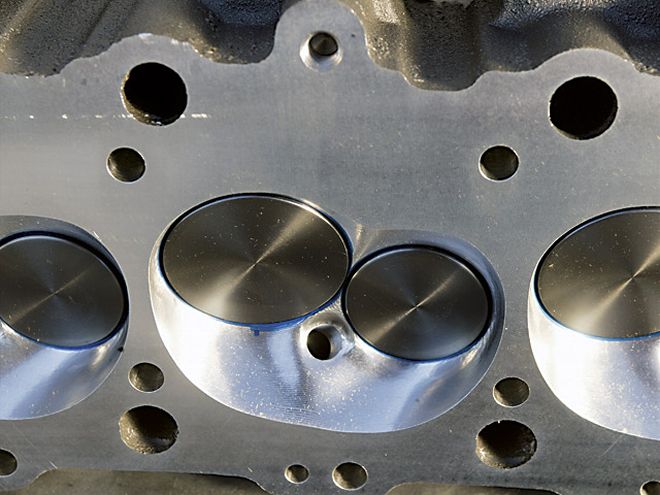 Points to note on this Scott Shafiroff 737 are that it is sporting a pair of split Dominators that, combined, flow in excess of 2,700 cfm. This means if you are building a small-block of...
Points to note on this Scott Shafiroff 737 are that it is sporting a pair of split Dominators that, combined, flow in excess of 2,700 cfm. This means if you are building a small-block of...
Also, those stretching an existing engine need to understand that if the cam's valve opening and closing events were correct for the original engine, they won't be so when the displacement is increased. Assuming the lobe centerline angle was correct originally, you will need to decrease (tighten) the lobe centerline angle by about 1-inch for every 16 inches the engine grows by. In some cases this can make for a pretty nasty looking piston crown because the valve notches could be deeper. Fortunately, there are two redeeming factors here: First, the bigger the cylinders are, the easier it is to achieve a given CR. This means that the piston dome will be smaller for the bigger engine. The second factor that plays into our hand here is that the higher the compression used the wider the optimum lobe centerline becomes. This means the high compression needed for those underfed cylinders actually works in our favor in terms of valve-to-piston clearance. A ballpark number here is that for every two ratios of compression increase the lobe centerline angle needs to be spread by 1-degree. By following the aforementioned advice on valve lift and lobe centerlines, you can really make the most of an engine that has grown significantly in displacement.
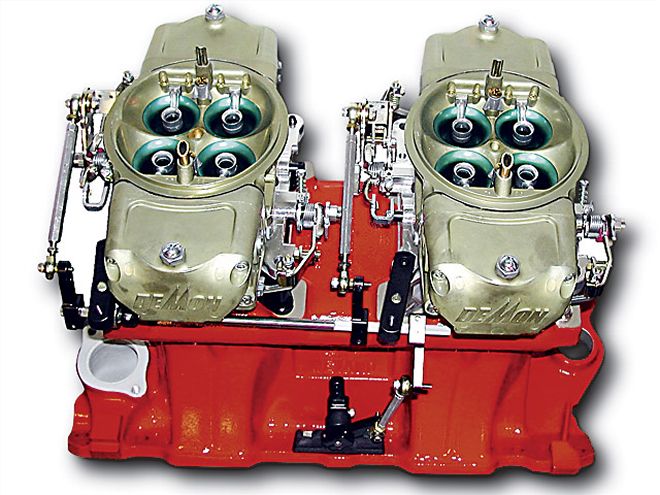 ...440 inches, carb capacity of about 1,620 cfm will be needed. This was just where we were with this Barry Grant Race Demon setup.
...440 inches, carb capacity of about 1,620 cfm will be needed. This was just where we were with this Barry Grant Race Demon setup.
Use An Adequate Induction System and Keep It Cool Because a bored/stroked engine has a greater difficulty filling its cylinders, we must (if both torque and top-end output are of any consequence) make sure there is no unnecessary restriction in the induction system other than the intake valve. This means no puny carbs. The induction system must have minimal restriction, thereby leaving as much pressure on the manifold side of the valve to push the charge into the partial vacuum in the cylinder. That workhorse of a 750 that produced such good results on a 350-inch engine is not going to cut it by a long shot on hardware stretched to 440 inches. Why? Because that 440-inch small-block is now looking like a big-block. Any time we have this many cubic inches we need to be thinking in terms of carbs of at least 850 cfm, and probably nearer a thousand. If the engine is to be a street driver and the intake you're planning to use is of the two-plane variety, be aware that it needs plenty of carb cfm because the manifold cuts the carb capacity in two.
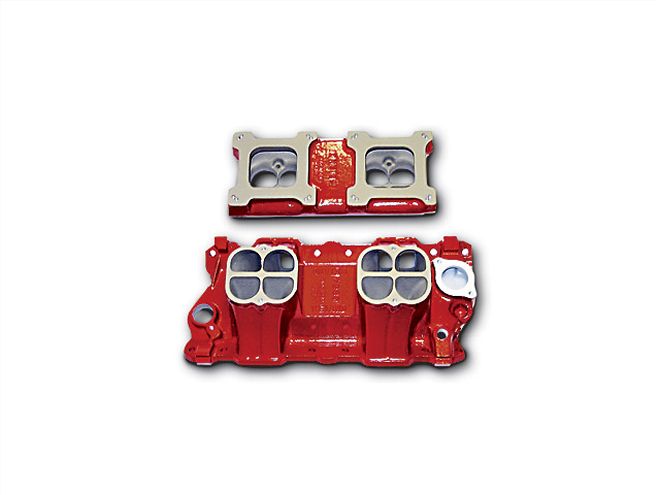 This small-block Holley manifold was given the full thermal barrier treatment by Calico Coatings. In addition to the intake runners, a thermal barrier treatment was also applied to the thermostat water jacket passage.
This small-block Holley manifold was given the full thermal barrier treatment by Calico Coatings. In addition to the intake runners, a thermal barrier treatment was also applied to the thermostat water jacket passage.
It is often stated that two four-barrel carbs on a tunnel-ram intake have a place only on the racetrack. I am not sure where this piece of disinformation came from, but the fact of the matter is that a 2x4 setup can actually make for a more streetable deal than an open-plenum single four-barrel intake.One last important point on induction systems for big inches: You need to be aware that the more air-starved the engine is, the more sensitive it becomes to charge temperature. Building an induction system that locates the thermostat somewhere else other than on the manifold pays dividends beyond what you might expect. On 540-inch big-block Chevys (and that's small by today's count) I've seen 20 hp more from a drop in intake charge of 20 degrees. If you want to go the next step--and this is just as worthwhile--then thermal management of the intake charge from filter to intake valve will pay off. A good start here is to apply a thermal barrier coating on the inside of the head and manifold runners as well as on the lifter valley side of the manifolds base. Also, since a considerable amount of combustion heat comes through the face of the intake valve it's also a benefit to output when given a thermal barrier coating.
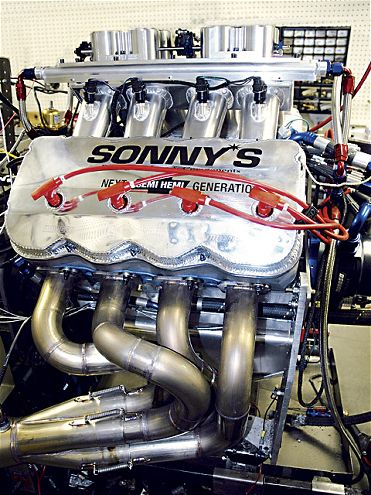
Sonny Leonard's Take On Big Inches
When asked for a few pertinent comments on big inch engines, Sonny Leonard had this to say: "A naturally aspirated 800-plus cubic-inch Pro Stock engine with our GM-compatible Hemi head is nothing short of a beast. These engines make around 1,750 hp at 7,600 rpm and 1,300 lb-ft of torque at 5,800 rpm. To harness this in a 2,400-pound five-speed Lenco-equipped Pro Stock car, super-low ETs are really a question of dialing in the clutch just right."
"Most drag-race engines for Top Sportsman and other high-end bracket classes have around 1,100 hp without nitrous and often use automatic transmissions. This combination, having less power and a converter to soften gearshift aggression, is far easier to utilize. As you might expect, all-out big-inch engines require more maintenance. The 1,750 hp they deliver doesn't just happen--it comes at a price. The super-high valve lifts and very big valves take their toll on valvesprings. With around 17:1 compression, spark timing and carb jetting is critical. With this type of engine the valvesprings and aluminum rods dictate a rebuild about every 30 quarter-mile passes. Going faster means more maintenance, and that means having a more knowledgeable crew. A 737-inch engine with our GM Hemi heads and two stages of nitrous delivers approximately 2,100 hp. Speed and larger cubes are always going to cost big money, so it's all a question of how fast can you afford to go. An IHRA 815-inch Pro Stock Hemi-headed engine will cost $92,000. However, if that's a little too steep, you can save 20 grand by going with my two-stage nitrous-injected 737-inch Pro Mod unit, as they only cost $72,000."
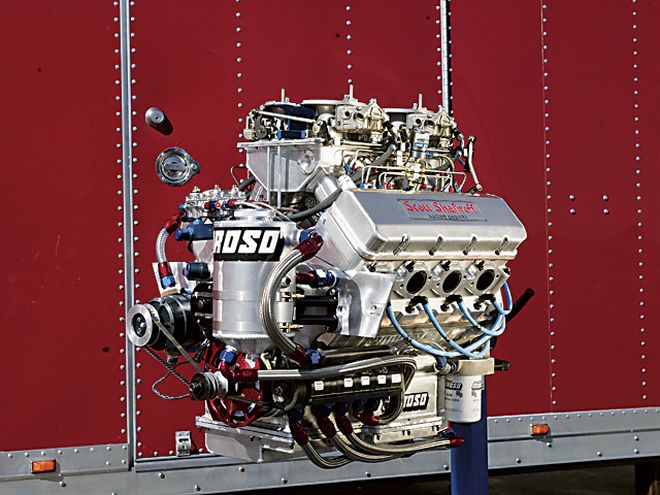
Scott Shafiroff On Big Engines
When asked for a few pertinent comments on big inch engines, Sonny Leonard had this to say: "A naturally aspirated 800-plus cubic-inch Pro Stock engine with our GM-compatible Hemi head is nothing short of a beast. These engines make around 1,750 hp at 7,600 rpm and 1,300 lb-ft of torque at 5,800 rpm. To harness this in a 2,400-pound five-speed Lenco-equipped Pro Stock car, super-low ETs are really a question of dialing in the clutch just right."
"Most drag-race engines for Top Sportsman and other high-end bracket classes have around 1,100 hp without nitrous and often use automatic transmissions. This combination, having less power and a converter to soften gearshift aggression, is far easier to utilize. As you might expect, all-out big-inch engines require more maintenance. The 1,750 hp they deliver doesn't just happen--it comes at a price. The super-high valve lifts and very big valves take their toll on valvesprings. With around 17:1 compression, spark timing and carb jetting is critical. With this type of engine the valvesprings and aluminum rods dictate a rebuild about every 30 quarter-mile passes. Going faster means more maintenance, and that means having a more knowledgeable crew. A 737-inch engine with our GM Hemi heads and two stages of nitrous delivers approximately 2,100 hp. Speed and larger cubes are always going to cost big money, so it's all a question of how fast can you afford to go. An IHRA 815-inch Pro Stock Hemi-headed engine will cost $92,000. However, if that's a little too steep, you can save 20 grand by going with my two-stage nitrous-injected 737-inch Pro Mod unit, as they only cost $72,000."